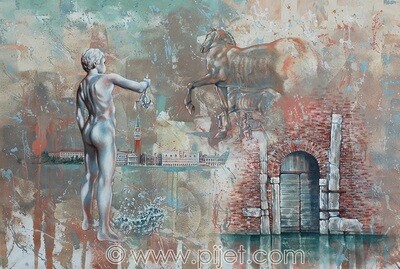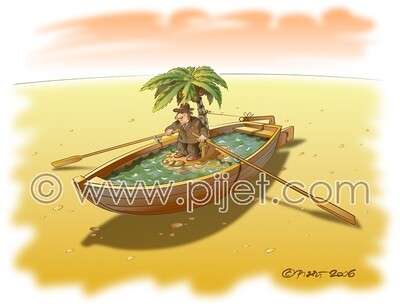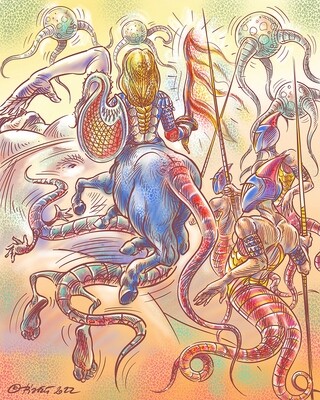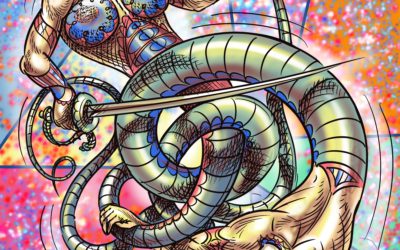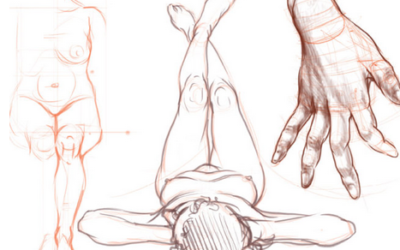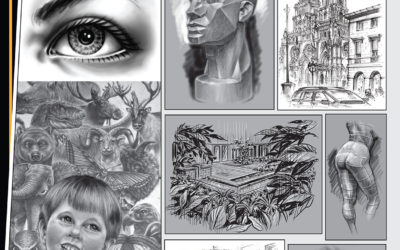“Woman Drinking Absinthe,” Van Dongen’s Allegorical Satire on Parisian Society.
The reputation of Paris as a leading center of important economic, socio-political and cultural changes was already well established in European social circles at the beginning of the twenty-century. The booming industrialization inspired various economic activities in every aspects of human existence. The market for the commodities of all kind was constantly growing and opening widely for business offering basically everything, including indecent services, as long as the buyer was able to afford its price. The city of Paris was becoming the international center of the world of fashion, entertainment, and Modern art. Despite its administrative problems related to the overwhelming population growth not followed by the infrastructural necessities in order to accommodate the new arrivals, Paris embraced everyone who was looking for a chance of a working space in the city. The artists from around the world were crossing each other on the streets of Paris, pursuing their dreams for a success and recognition of their talent. Kees Van Dongen,[1] whose exposition is hosted at the present by the Museum of Fine Arts in Montreal, was one of many who tried to establish his artistic personality in Paris, and one of the few who was able to do it successfully during his lifetime.
The Van Dongen’s exposition in Montreal gathered artworks from different periods of his artistic carrier. The artwork, which captures a particular attention is the drawing titled, “Woman Drinking Absinthe” (see fig.1). The magnetic power of this artwork attracts the viewer not only for its aesthetics, but also because of its psychological content. The drawing was executed in the year of nineteen oh-two. It is one of many from the series of artworks[2] created by Van Dongen during his first years of staying in Paris.[3] It was the time when he had to struggle for surviving by drawing portraits of people in cafeterias and on the streets in order to be able to sustain him-self and his young family. Van Dongen’s sharpness of his allegoric statement is emanating from this artwork at the viewer with horrifying exposure of the psychological summary of French classes. It is an artwork depicting the social degradation of Parisian society. This drawing differs from all the others exposed in the museum. In this artwork Van Dongen made editorial comment taking as a subject the problem of prostitution in Paris. At first regard the artwork gives an impression of humoristic view on the male versus female relations. However, this particular drawing Van Dongen executed not in the conventional realistic way as he did with the other drawings. This time the semiotic ambiguity of his judgment of the social degradation is enforced by psychological allegory to the human basic instincts. He exposes the animal nature of human beings. It is a dark satire on the imperfection of the phallic social system. Besides the editorial subjectivity the artwork does not have yet the “Van Dongian” fauvist flavor. Instead, the aesthetics and technical particularities of the drawing ”Woman Drinking Absinthe,” suggest enormous influences of Toulouse-Lautrec’s artistic style. Especially in this particular artwork the freedom of the brush is definitely borrowed either from Toulouse-Lautrec, or Edgar Degas, or from both of them at the same time.[4]
Submitting the artwork to the closer examination of its symbolic allegorical meaning, it is necessary to begin with the general description of its content. Van Dongen depicted a seating woman on the street in black dress with her legs covered with black stockings spread widely in a provocatively inviting position in the direction of the metamorphic skeleton of either a rabbit, or a dog, with a human skull and a tuxedo hat on it. The seating position of the skeleton suggests a rabbit, what symbolizes besides many other meanings the dishonesty, damaging activities, as well as a man’s libido. We can also consider that it is a hesitating dog, not sure if the tempting garter in the hand of the woman is worth the bite. In such case, the dog symbolizes greediness and bad habits. Both descriptions fit well to the image. The woman, according to the title of the drawing, is drunk what would symbolize her weakness and frivolity. Her head is covered with the hat having an evident unspecified red decoration on it. Her lips are in red and the visible underwear between her legs is red too. The red color goes from her head through her lips to the woman’s underwear. It is symbolic reference to the three steps of merchandising the prostitute services. The first is the idea of selling her body for money. The second is her mouth, through which she would trade with the client. The third would be the final consumption of the purchased “ goods.” The Woman is supporting her seating figure on her right hand preventing her-self from falling, and with her left hand stretched out and grasping her garter. She is trying to attract the metamorphic creature between her legs. The scull of the creature has an opened mouth, what emphasizes his hunger and the desire to bite the garter, or more. The spread legs are actually preventing the metamorphic creature from escaping, exposing the red flounces as an additional element of temptation. The drawing is executed with great artistic freedom of the brush and mixed media.[5] The image provocative composition is catching the viewer in its psychoanalytic imaginary spider net. From the psychological point of view the image itself does to the viewer exactly what the woman does to the metamorphic creature. It emanates the temptation. It attracts the viewer’s attention by its unusual allegoric symbolism. It is Van Dongen’s the only artwork at the exposition with the surrealistic taste. The allegory of this image is evident and represents the essence of Parisian realities viewed through the critical perception of the artist’s intellect. Van Dongen’s irony in this drawing reflect the consequences of industrialization and its impact on the style of living of those less fortunate who become a merchandise for those who can afford it. The prostitution in Paris become affordable commodity and followed closely the development of consumer society. The difference in the sizes between the woman and the metamorphic creature figures symbolizes how serious the problems of social inequities were at that time, and how devastating the prostitution was as means of gaining a leaving, especially for women.[6] The overwhelming figure of the lady refers to the demography of poverty among the lower classes of Parisian society, which was ruled by the financial power of the bourgeoisie and the capitalist exploratory system, which on the image is represented allegorically as the metamorphic creature. The artwork represents in it-self a sort of diagram of economic divisions between the poor and the rich classes in Parisian society at the beginning of the twentieth century. The skeleton beast refers to the phallic demoralizing attitude towards the lower classes. It reflects the elaborated taste of the bourgeoisie to the commodities available to them through their monetary power. Furthermore, in reference to Benjamin Walter’s[7] writings about Baudelaire’s allegorical symbolism in his poetry, the seating woman represents allegorically the social devaluation of human dignity to the object of commodity. Van Dongen, during the time of working on the editorial illustrations for the magazines, produced great deal of drawings. Each of them was accompanied with an intelligent spicy to the point commentaries, but in the drawing “Woman Drinking Absinthe,” he proved his great talent of critical psychoanalytic artistic judgment and elaborated perversity of intellectual thought.
In reference to Kant’s[8] writings about art regarding the importance of knowledge for creating and understanding the art, the interpretation of Van Dongen’s drawing “Woman Drinking Absinthe,” will be quite different. If taking in consideration Van Dongen’s Parisian realities at the beginning of his carrier, analyzing his artwork without any knowledge of any specific details about his personal life, the viewer would come to less or more the same interpretation of his drawing as it was explained earlier in this paper. However, knowing of the hardship of his life at the beginning of his Parisian period, as well as his brilliant carrier, which started few years later, this artwork represents the artist him-self and his Parisian realities. The drawing “Woman Drinking Absinthe” illustrates an unconscious prediction of Van Dongen’s own future. Van Dongen in his own words stated in his biography: “I am a prostitute of my glory.”[9] Van Dongen’s well being depended on the bourgeoisie interest in his art. In such case the reading of the artwork “Woman Drinking Absinthe” will be different. The female character would represent Van Dongenès affords to attract attention to his talent and his artistic services. The meaning of the metamorphic character would not change. The creature will still represent an important monetary aspect, but in different sense. This time it would be the bourgeoisie’s taste for Van Dongen’s art. The artist in this artwork exteriorized his own artistic struggles. He referred him-self as a prostitute, because from the beginning he had to put aside painting and concentrate on publishing in order to survive. The ambiguity of this drawing could refer to Plato’s “problem” with the art, when he said that the artists speak through the images more than through the ideas, what makes the truth cloudy and so not clear.
Most artists are trying through their art to extract their psychological complexity. Seemingly to Van Dongen, Jean Cocteau[10] tried to visualize in his surrealist movie,” The Blood of a Poet,” the nuances of artist’s interiority. Louis Bunuel[11] and Salvador Dali[12] tried to do the same in their movie “An Andalusian Dog.”[13] Through the psychological collages of allegorical imagery, the viewer as well as the artist, is trying to make a sense of the mysterious world of the creative mind.
Van Dongen’s artwork exposes the psychological mirror of Parisian realities. He experienced it by leaving in doubtful neighborhoods at the beginning of his crusade for the fame and glory. The world where Van Dongen was searching for recognition was the world he criticized brilliantly in his early years, and portrayed it with a great success later. It was the world he depended on through all his life, as his female symbolic character in his drawing “Woman Drinking Absinthe.”
[1] Kees Van Dongen, Daitch painter, born in 1877 in Delfshaven, the Rotterdam’s suburbia’s. He arrived in Paris the first time in 1997, than the second time in 1900, a year of the opening of the first line of metro in the city. Van Dongen was the only faithful representative of Fauvism through almost all his life.
[2] Van Dongen was able to obtain the contracts for satirical illustrations for such French reviews as: La Revue Blanche, Le Rire, L’Assiette au Beurre, and after nineteenth and three the Gil Blas.
[3] Van Dongen first came to Paris in eighteenth ninety-seven but had to live because of financial difficulties. He returned again in nineteenth and decided to stay. In nineteenth and one he got married in Paris with Augusta Pretinger. He had one daughter with her.
[7] Benjamin Walter (1892 – 1940), Jewish – German critic and philosopher. He considered as a key figure of the Western Marxism.
[8] Immanuel Kant (1724 – 1804), German philosopher and the author of Critique of Judgment, Critique of Practical Reason, Critique of Pure Reason. He is one of the most influential philosophers through the history of Western philosophy
Bibliography
Crespelle, Jean-Paul. Les Fauves. Éditions Ides et Calendes, Neuchâtel, 1967.
Dorival, Bernard. The School of Paris, in the Musée d’Art Moderne. Thames and Hudson, London, 1962.
Freud, Sigmunt. 1. Introductory Lectures on Psychoanalysis. Pelican Books, London, 1991.
Gilson, René. Jean Cocteau Cinéaste. Lherminier Editions des Quatre-Vents, Paris, 1988.
Melchior-Bonnet, Sabine. Histoire du Mirroire. Editions Imago, Paris, 1994.
Weiss, Peter. Cinéma d’Avant-garde. L’Arche, Paris, 1989.
Leeman, Fred. “The Van Dongen Nobody Knows, Early and Fauvist Drawings, 1895-1912.” Exhibition Catalogue by Anita Hopmans. Master Drawings, Vol. 36, No. 3 (Autumn, 1998), pp. 316-318.
Zdebik, Jakub. ARTH-383 Course Pack, Art and Philosophy. Concordia University, Faculty of Fine Arts, 2009.

